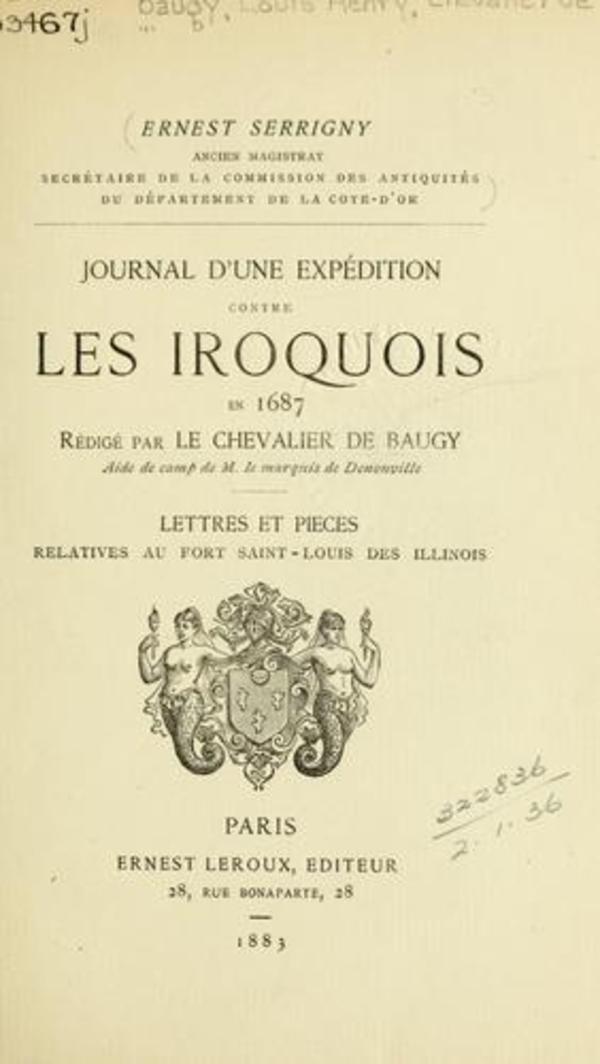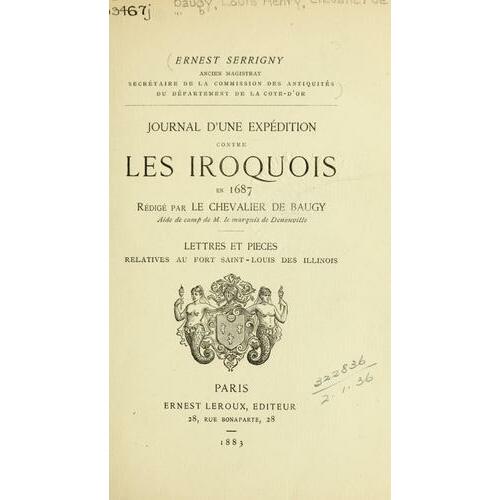
Source: Link
BAUGY, LOUIS-HENRI DE, known as Chevalier de Baugy, military officer; b. 29 Sept. 1657 in Villecien, France, and was baptized 30 Sept. 1660; he was born into a noble family of the province of Berry, being the son of Guillaume de Baugy, a king’s councillor and captain of light horse in Cardinal Mazarin’s regiments, and Gabrielle de Goué; m. 24 Nov. 1705 Anne Regnault in Villecien; d. there 19 Feb. 1720 and was buried the same day.
Louis-Henri de Baugy sailed for Canada from La Rochelle on the night of 12–13 July 1682 on the Saint-François-Xavier. He arrived at Quebec in October together with Le Febvre* de La Barre, who was succeeding Buade* de Frontenac. The new governor, under pressure from the group of merchants who envied the advantages enjoyed by Cavelier* de La Salle in the Great Lakes region, undertook to deprive the explorer of his possessions. He entrusted this mission to Morel de La Durantaye, a former captain in the Régiment de Chambellay, to whom he assigned the Chevalier de Baugy as lieutenant. According to their commission dated 1 and 15 March 1683 and the instructions that followed on 20 April, they were under orders to seize the canoes of the coureurs de bois who did not have a fur-trading licence; to urge the Illinois, Tionontati, and Miami to take their pelts to Montreal; to keep a close eye on La Salle and seize his possessions if the accusations levelled against him proved to be correct.
On 23 April 1683 the two left Quebec for Michilimackinac, where they arrived on 2 July. While La Durantaye was setting himself up at Michilimackinac, Baugy proceeded towards Fort Saint-Louis des Illinois. On the way, when he was 15 leagues from the fort, he met La Salle, who was returning to Montreal. Informed of Baugy’s mission, La Salle deferred to him. La Salle wrote a letter to his partner Henri Tonty, the commandant of Fort Saint-Louis, asking him to receive Baugy courteously. Tonty obeyed, handing over command of the fort to La Barre’s envoy, but he remained on the spot to attend to La Salle’s interests.
There was frequent friction between Tonty and Baugy, who was looking after La Barre’s interests. Baugy tried in vain to entice away Tonty’s men who, in return for increased wages and promises of land grants, remained loyal to La Salle. On 21 March 1684 the two rivals had to forget their quarrels to organize the defence of the fort, which was being threatened by 200 Iroquois (Haudenosaunee). The siege lasted six days. Baugy dispatched a courier to Michilimackinac. Thanks to support from a party of Illinois, however, they succeeded in repelling the Iroquois well before the arrival of La Durantaye and his men. When La Durantaye reached the fort on 21 May he brought with him precise orders from La Barre: Tonty was to leave the fort and Baugy to take over sole command.
While Baugy was enjoying a monopoly of the fur trade among the Illinois, La Salle was successfully pleading his case at Versailles. Reinstated in his privileges by the king, La Salle dispatched Tonty to Fort Saint-Louis as its governor. Tonty presented himself at there on 26 June 1685. The tables were turned: Baugy was obliged in his turn to leave the fort and go back to Quebec.
We find no trace of Baugy in any records until the spring of 1687, when he took part as Brisay de Denonville’s aide-de-camp in the campaign against the Seneca, who belonged to the Iroquois confederacy. In the valuable account that he left of this action Baugy tries to demonstrate great care in being exact and precise. Denonville highly appreciated his aide-de-camp’s services during this campaign and thought fit to recognize his merit by granting him the honour of a company in Canada.
Baugy did not die in 1689, as Pierre Margry wrote, but went to France in November of that year. He never returned to Canada. As seigneur of Villecien, Villevallier, Fay, and other places, he lived in his château at Villecien. On 19 Feb. 1696 he was appointed captain-major at Saint-Julien-du-Sault. He died on 19 Feb. 1720 and was buried that day in the parish cemetery in Villecien.
Baugy, Journal (Serrigny). Découvertes et établissements des Français (Margry), V, 4–7. Ord. comm. (P.-G. Roy), II, 3–33, 43. Eccles, Frontenac. E. R. Murphy, Henry de Tonty, fur trader of the Mississippi (Baltimore, 1941). Benjamin Sulte, “Les Tonty,” RSCT, 1st ser., XI (1893), sect.i, 3–31.
Bibliography for the revised version:
Arch. Départementales de l’Yonne (Auxerre, France), “Reg. paroissiaux et de l’état civil (collection du greffe),” Villecien, 30 sept. 1660, 24 nov. 1705, 19 févr. 1720: archivesenligne.yonne.fr/archive/recherche/etatcivil (consulted 13 June 2023).
Cite This Article
Jean Hamelin, “BAUGY, LOUIS-HENRI DE, dit Chevalier de Baugy,” in Dictionary of Canadian Biography, vol. 2, University of Toronto/Université Laval, 2003–, accessed January 1, 2026, https://www.biographi.ca/en/bio/baugy_louis_henri_de_2E.html.
The citation above shows the format for footnotes and endnotes according to the Chicago manual of style (16th edition). Information to be used in other citation formats:
| Permalink: | https://www.biographi.ca/en/bio/baugy_louis_henri_de_2E.html |
| Author of Article: | Jean Hamelin |
| Title of Article: | BAUGY, LOUIS-HENRI DE, dit Chevalier de Baugy |
| Publication Name: | Dictionary of Canadian Biography, vol. 2 |
| Publisher: | University of Toronto/Université Laval |
| Year of publication: | 1969 |
| Year of revision: | 2023 |
| Access Date: | January 1, 2026 |



